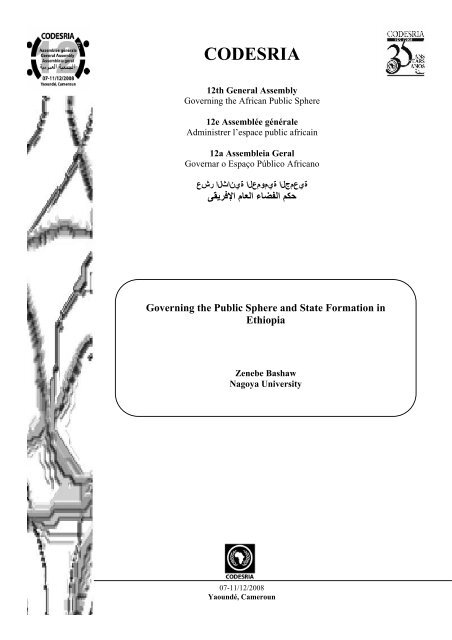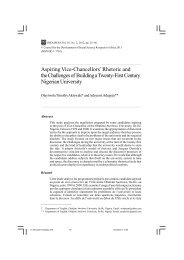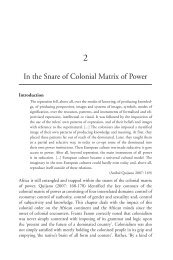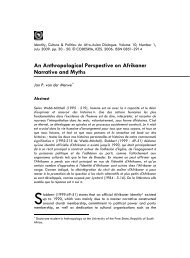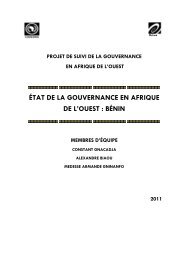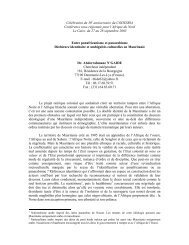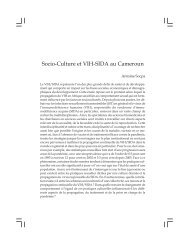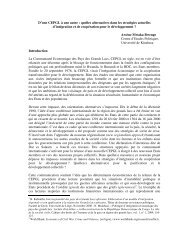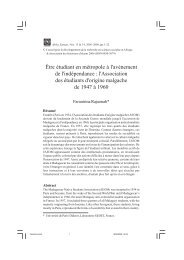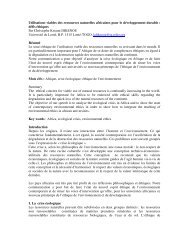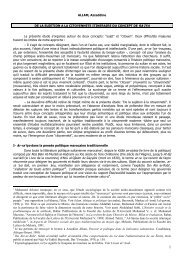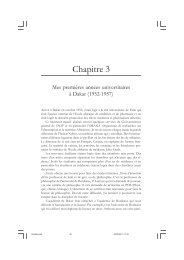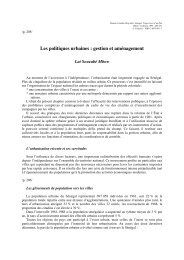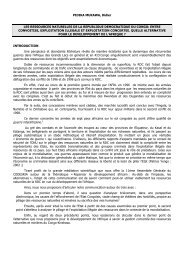Zenebe BASHAW - codesria
Zenebe BASHAW - codesria
Zenebe BASHAW - codesria
Create successful ePaper yourself
Turn your PDF publications into a flip-book with our unique Google optimized e-Paper software.
CODESRIA<br />
12th General Assembly<br />
Governing the African Public Sphere<br />
12e Assemblée générale<br />
Administrer l’espace public africain<br />
12a Assembleia Geral<br />
Governar o Espaço Público Africano<br />
عشر الثانية العمومية الجمعية<br />
ﻰﻘﻳﺮﻓﻹا مﺎﻌﻟا ءﺎﻀﻔﻟا ﻢﻜﺣ ﻢ<br />
ﻜﺣ<br />
Governing the Public Sphere and State Formation in<br />
Ethiopia<br />
<strong>Zenebe</strong> Bashaw<br />
Nagoya University<br />
07-11/12/2008<br />
Yaoundé, Cameroun
1. The Problem<br />
The discourse and practice of the public sphere has for long been conceived as arena and<br />
space which private citizens create as a public in order for them to debate the general rules<br />
dictating relations in society (Habermas, 1989; Calhoun, 1992). It is only when such arena<br />
and space is depersonalized and able to create relatively functioning and independent civil<br />
society that it serves the purpose of strengthening transparent and durable institutions.<br />
Situating this to Ethiopia connotes the main players of the public sphere to be a wide range of<br />
actors in urban and rural communities, such as students, peasants, ethno-linguistic groups,<br />
workers and religious and local leaders. These are agents that represent and manifest the<br />
composition, characteristics and trend of the public sphere. Indeed, its comprehensiveness and<br />
broader understanding perhaps leads to delineating the public sphere as synonymous with<br />
society or its main germane fabric as a whole. The successive states in Ethiopia have been at<br />
the center of organizing and countering the forces of the public sphere, for politics in the<br />
country has essentially been how best to incorporate the different forces of the public sphere<br />
that make up the different states: the empire state, the Marxist state and the ethno-political<br />
state (see Berhanu, 1998).<br />
The purpose of this paper is to examine how the successive states since the creation of<br />
modern Ethiopia have been unable to successfully govern the public sphere with durable and<br />
well-functioning institutions. The paper contends that one main source of protracted conflicts<br />
in the country lies in the incapacity and unwillingness of successive states in allowing the<br />
forces of the public sphere to be part of the process of state formation. Rather the process of<br />
state formation is marked by strong elites who control weak institutions and negotiate among<br />
themselves. Political power has not been vested in the public sector, and the forces of the<br />
public sphere have not been in a position to articulate and discuss the notion and “subjective<br />
aspect” of the successive states in Ethiopia, i.e., how the states exist in their minds and hearts<br />
that they rule and control.<br />
This occupies an important place in the governance of the public sphere for the reason that the<br />
concept of the state that a number of people theorize is “invisible; it must be personified<br />
before it can be seen, symbolized before it can be loved, imagined before it can be conceived”<br />
(Walzer, 1967: 194). As identities give meaning to the continuity of the state, the state as an<br />
institution strengthens or weakens the importance of national identities, and is their<br />
representation. The further alienation of the forces of the public sphere from decisions in the<br />
1
(re)distribution of resources, political participation and the freedom to organize erodes the<br />
capacity of the successive states from “broadcasting” and “radiating their power” from the<br />
center to “cover a … territorially, demarcated area over which it exercises” (Mann, 1986: 112;<br />
Herbst, 2000).<br />
To be sure, the challenges of effectively governing the public sphere in the process of state<br />
formation in Ethiopia have been bedeviled by the interplay between “territorial deficit” and a<br />
“deficit of integration” (see Darbon, 1991: 41). Not only do the different states lack<br />
substantial control over areas beyond the seats of governments, they have also been<br />
constrained in their capacity to maintain law and order, to extract revenues and to place<br />
effective administrative systems. What Christopher Clapham (1999: 57) identifies as the<br />
“shrinking of the state away from the peripheries of its formal national territory, and its<br />
concentration in the capital and the major cities, and in the most important areas of export<br />
production” constitutes the underlying historical nature of the successive states. And states<br />
that fail to govern the public sphere successfully lack coercive, integrative or incorporative<br />
and (re)distributive capacities and legitimacy to effectively penetrate society.<br />
2. Significance<br />
A state as an organization claims the monopoly of violence in a defined territory and for its<br />
recognition by other states and/or acceptance by agents of the public sphere as the ultimate<br />
provider of public and political goods for its people. State formation is a continuous process<br />
in territorial expansion and consolidation, regulation of social relationships coupled with<br />
“standardization” or constitution of identities. It also constitutes extraction and<br />
(re)distribution of resources and provision of public goods (Weber, 1978: 905; Rokkan, 1975:<br />
570-575; Skocpol, 1985: 21). State formation is a continuous process of developing the<br />
center’s territorial claim and effective control over the periphery. It is also a process in the<br />
monopoly of legitimate force. It implies “the assertion of a territory, a center, over others, in a<br />
kind of internal conquest, which only gradually and to a varying extent became a process of<br />
integration” (Rao and Suphellen, 1996: 81). With the risk of oversimplifications, the history<br />
of state formation is a history of defining political power territorially. By state formation, this<br />
paper underlines the formation, change, reformation, and deformation/exist of a state as a<br />
territorial organization.<br />
The significance of looking into the relationship between governing the public sphere and<br />
state formation is evidenced, first, by the need to institutionalize functioning and durable<br />
2
states’ institutions which are inseparable from expanding the political and economic space for<br />
forces of the public sphere. The capacity to effectively governing the public sphere also serves<br />
as a source of rule-based function of government structures for the effective provision of<br />
public goods, and transparent accountability rules that govern the actions of both state and<br />
private sectors.<br />
Second, studying the public sphere as the foundation for political and social communities, and<br />
the state as an institution is concerned with examining the importance of history, power, and<br />
symbolic action to the understanding of the political economy of a country (March and Olsen,<br />
1984). The state was described as the leviathan and the public enemy, and its role in society<br />
has been fiercely debated. Whilst some rush to write obituaries for the decline and eventual<br />
demise of the state, its existence and capacity in developing countries constitutes issues of<br />
survival, peace and development.<br />
Third, more than any time in the modern history of most developing countries, the question of<br />
how the state (re)constitutes itself is inseparable from how to build relatively durable peace.<br />
In societies that have been undergoing through turbulent and difficult periods, how best to<br />
incorporate actors of the public sphere into the state is an issue that deserves due attention.<br />
The nature of the relationship between the state and actors of the public sphere is the source<br />
of state capacity and its continuity as a viable institutional entity. This is mainly due to what<br />
John Guidry and Mark Sawyer called “contentious pluralism”, a space created with the<br />
participation of agents of the public sphere in contributing and strengthening the<br />
democratization of the state (2003: 273).<br />
3. Conceptualizing the Public Sphere and State Formation<br />
The past century was described as a “great age of state formation” and poses one of the most<br />
challenging questions in political economy (Erthman, 1997: 1). It is difficult to explain “why<br />
have many Third World states remained weak or achieved only middle-level capabilities, and<br />
why have a few others been able to avoid such weakness?” (Migdal, 1988: 261).<br />
Historically scholars from Bodin to Machiavelli, Hobbes, Locke, Marx and Weber explored<br />
the origin of the state, its nature and trajectories. Recent interest in the study of the state and<br />
state formation has two sources. First, there is a presumption that the state is in decline. The<br />
position of the nation-state as unit of social organization is “weakened” due to external<br />
3
political and economic pressures by transforming the location of power from the national to<br />
the supra and global level. External constraints are often accompanied by domestic demands<br />
for devolution of power and increased local autonomy (see Habermas, 1996; Spruyt, 2002).<br />
Second, there is a growing interest in state weakness and failure with its serious consequences<br />
for human security and its threat to regional and international security. The challenge of<br />
building durable political institutions in developing countries adds to the growing interest.<br />
State penetration of the public sphere, or what Barbara Haskel alternatively calls “access to<br />
society”, is a function of a particular state’s capacity (1980: 90). The relationship between the<br />
state and agents of the public sphere is mainly concerned with how best to maintain the<br />
autonomy of the state without isolating itself from agents of the public sphere, or being<br />
“captured” by them. The debate in the relationship revolves around understanding whether the<br />
state has autonomy, its origin is located in the public sphere (public sphere embeddedness), or<br />
the state and the public sphere have mutual embeddedness (state autonomy and public<br />
sphere).<br />
Isolated autonomy, mainly advanced by neo-Weberian and state-centric theorists, gives<br />
ontological primacy of the state over the public sphere. The strength of the state is measured<br />
how successfully the state “insulates” itself from the public sphere, and vice versa. In the<br />
1960s the interest was to examine how the new post-colonial states could build successful<br />
state institutions for effective “governability” with stable political order (Huntington, 1968).<br />
Theda Skocpol, one of the most ardent proponent of state autonomy, argues that the autonomy<br />
of the state is ascertained when it is able to pursue and implement goals that do not<br />
necessarily reflect the interest of any other entity(ties) (1985: 9). Fred Block, an equally<br />
strong advocate of state autonomy, views states as inherently autonomous organizations and<br />
contends that “[s]tate power is sui generic”, i.e., it is not reducible to society or class power<br />
(1980:229).<br />
The isolated autonomy argument was developed in reaction to Marxist and liberal conception<br />
of the state. This public sphere-centered approach contends any plausible inquiry about the<br />
state departs from the formation of space by the public sphere. The nature, trajectory and<br />
structure of the state emerge from class or individual relations. Marxist or neo-Marxist<br />
approach views the state in its instrumentality for the interest of the dominant class with the<br />
exception of its “relative autonomy.” When the state is unable to function in balancing the<br />
4
competing interest of the dominant class, it weakens and “withers away”. Using the<br />
embeddedness of the state in class relationships, John Hobson shows how late-Victorian<br />
British state was able to increase its extractive capacity, while Tsarist Russian state, that was<br />
isolated, had weaker fiscal capacity (1997: 236 and 240). The state is not only viewed in its<br />
functional aspect, but also as an arena in which different groups of the public sphere contest.<br />
The strength or weakness of the state therefore is whether it is able to serve as a “neutral<br />
arbiter” from which its legitimacy derives (Levi, 1988). State-in-public sphere approach, on<br />
the other hand, posits that the state’s autonomy is enhanced and its capacity strengthened<br />
through its “connectedness” to the public sphere (Evans, 1995: 50). Such a state is able to<br />
coordinate its connectedness with forces of the public sphere by mobilizing resources and<br />
harnessing “a sufficiently, coherent, cohesive state apparatus” (Weiss, 1998; Evans, 1995).<br />
The boundary between state and public sphere is “elusive, porous, and mobile” and state<br />
strength or weakness and legitimacy are variables, not constants (Mitchell, 1991; Holsti,<br />
1996: 90). The strength or weakness of a state is based on the depth and breadth of<br />
penetration of the public sphere by states’ institutions. This also depends on understanding<br />
states as “coercion-wielding organizations that are distinct from households and kinship<br />
groups and exercise clear priority in some respects over all other organizations within<br />
substantial territories” (Tilly, 1990:1).<br />
Two central issues are outstanding when discussing the concepts of the public sphere and<br />
state formation. First, both concepts have been marked by contours that show transformations.<br />
They are far from products uniformly developed in short periods of time, and more often than<br />
not they undergo continuous changes. The infusion of social norms, rules and values produce<br />
public sphere that gives rise to distinctive political and social communities which seek and<br />
espouse increased participation and expression of ideas. The public sphere as space and<br />
constellation of perceptions/imaginations constitute one crucial element of state formation (cf.<br />
Anderson, 1991). Benedict Anderson’s (1996) treatment of nation-states as “imagined<br />
communities” supposes the conceptualization of the state as far from universal and inherent,<br />
rather as an artificial but resilient construction and amalgamation of identities that give<br />
meaning to states. This is at the same time similar to what Charles Taylor views the public<br />
sphere as being an important constituent part of the “social imaginary” created as a space<br />
outside the power of the state, alternatively described as an “extra-political” status of the<br />
public sphere (2004: 83-99).<br />
5
The process of state formation also indicates different historical contexts, and a wide range of<br />
states’ disparate “collectivities” (Vincent, 1987). It is a process in the formation, change,<br />
reformation, and deformation/exist of a state as (territorial) organization (see Desch, 1996;<br />
Burke, 1997; Porter, 1999). As a case in point, contemporary processes of state formation,<br />
which could be generally classified in four waves, followed the collapse of empires and their<br />
“de-territorialization”: The collapse of the Spanish Empire in early nineteenth century led to<br />
state formation in South America; the Austria-Hungary and Ottoman Turkish Empire gave<br />
rise to new European states after First World War; the weakening of the European colonial<br />
powers brought about decolonization in Africa and Asia; and the disintegration of the Soviet<br />
Union created the commonwealth of independent states (Chazan, et al., 1991).<br />
Second, the understanding and practice of the public sphere and state formation in developed<br />
Western countries is quite divergent from its conceptualization, historical trajectories and<br />
mechanisms of its manifestation in developing, especially African countries. Besides, what<br />
actors/agents constitute/dominate the public sphere and how one makes a distinction between<br />
the “public” and the “private” appears to be unique. Since its articulation and in-depth<br />
analysis by J. Habermas in his study The Structural Transformation of the Public Sphere<br />
(1989), the public sphere was debated and examined from the 17th and 18th century European<br />
context and the development of the bourgeois society. The main players of the public sphere<br />
remained restricted that omit the inclusion of other societal forces. This perhaps is what<br />
compelled Karl Marx to characterize the state, mainly the capitalist state, as the instrument of<br />
the ruling class, which, with the exception of “abnormal times”, might have “relative<br />
autonomy” to balance the competing interests of the ruling class. It does not have autonomy<br />
and is dependent on the bourgeoisie class (Carnoy, 1984: 53; Hall and Ikenberry, 1989: 7).<br />
Employing books, salons, clubs, newspapers and other media as instruments, agents of the<br />
public sphere were able to create communicative forum or space with the potential of creating<br />
the “ideal speech situation” and thereby challenging the traditional spheres of claiming and<br />
legitimizing authority by the church and the state (mainly personified by a monarch or king)<br />
(see Hartley, 1992). Habermas conceptualizes the public sphere as:<br />
a realm of social life in which something approaching public opinion can be<br />
formed….and in which citizens can confer in an unrestrictive manner – that<br />
is, with the guarantee of freedom of assembly and association and the<br />
6
freedom to express and publish their opinions-about matters of general<br />
interest (1974: 49)<br />
.<br />
Non-European process of state formation, specifically in Africa, is quite different both in its<br />
nature and the states that came into existence. Whilst there were extensive changes in<br />
territorial configuration during state formation in Europe, which occurred analogues to the<br />
process of “natural selection”, most African countries showed little, if not any, external<br />
territorial changes. A closer look at the maps of Europe and Africa, for example, during the<br />
respective process of state formation is indicative of more extensive territorial changes in the<br />
former than the almost territorial continuity in the latter. The major changes in Africa were<br />
internal in the course of the successive states’ attempt to claim control over agents of the<br />
public sphere mainly ethno-linguistic groups and regional/local leaders, while the externality<br />
of the territories were arbitrary determined by the colonial powers. It was an attempt to<br />
configure and reconstitute the internal dynamics of the “container” rather than to challenge<br />
the space that bounded the states. State formation did not place the “guns” (war), the “money”<br />
(formation of bureaucratic structures and capacities to mobilize people and resources) and the<br />
“lawyers” (nation-building and relationships with agents of the public sphere) for the<br />
emergence of territorial states as durable organization (see Schwartz, 2000: 20; also Ertman,<br />
1997: 6). The first two, when complemented by the last, become, to use John Brewer’s (1988)<br />
words, “the sinews of power”.<br />
The manners that forces of the public sphere posed their resistance to the dominant and often<br />
dictatorial elites in Africa were also different from the open engagement and dialogue for<br />
changes and increased participation in Europe. Seen from broader theoretical-cum-empirical<br />
studies, there have been various lines of research on alienation, political trust, modes of<br />
participation, political efficacy and the like that are employed to measure political legitimacy<br />
of the state vis-à-vis agents of the public sphere (Weatherford, 1992: 149). Similar to the<br />
challenge of how one understands the hidden aspects of power as posited by the second<br />
dimension of power (Lukes, 1974; Gaventa, 1980), an examination of the acceptability of a<br />
state’s institutions by forces of the public sphere in weak Third World states, or what Michael<br />
Schatzberg calls its “thinkability” (2001: 1), is faced with the problem of assessing the<br />
attitudes of actors of the public sphere towards political authority. Its better understanding<br />
therefore requires looking at the socio-cultural frames of opposition of agents of the public<br />
sphere (Geertz, 1973; Schetzberg, 2001). Social-cultural frames of opposition mainly<br />
7
constitute what James Scott calls “infrapolitics” or “disguised resistance” (1990: 199). Agents<br />
of the public sphere who are discontented and oppressed employ innocuous, but powerful<br />
ways of resistance. This “everyday resistance” includes rumors, gossip, folktales, songs,<br />
gestures, jokes, and theatre (Scott and Kerkvliet, 1986: 1; Scott, 1990: xiii). Under situations<br />
of “hopeful hopelessness”, they serve as initiators of resistance and agencies of change that<br />
eventually have the possibility of connecting to protracted conflicts (Wendt, 1996: 264; Stern,<br />
1987: 9).<br />
It should be mentioned here that Habermas’ depiction of the public sphere was intended to<br />
characterize a modern and rationalized policy built on the basis of consensus (Habermas,<br />
1984a, 318-319; 1989, 2-4; 1990, 56). As such, the main purpose of the public sphere was to<br />
legitimize state’s authority, at times with the role of challenging it (Rutherford, 2000). The<br />
temporal feature of the public sphere, however, began to show changes predominately<br />
involving its “refeudalization”. This process is accompanied, first by the diversification and<br />
increased roles of different actors, mainly the private sector, thereby challenging the “billiard<br />
ball” status of the state. This is done through enunciating such key elements as expanding the<br />
share of the private sector in the provision of services through contracting out, the<br />
decentralization of public sector management such as the devolution of budgets and financial<br />
control by institutionalizing new autonomous agencies (“agencification”), and the inclusion of<br />
customer-oriented services and performance (See OECD, 1995; Hood, 1995; Peters and<br />
Pierre, 1998).<br />
On the other hand, as a counter to these changes, the state assumes important position as a<br />
bastion of protecting its authority from erosion by supplying public goods which other actors,<br />
including the private sector/market, inherently lacks (such as the Pareto efficiency/optimality<br />
and the corresponding features of non-rivalness and non-excludability of public goods as well<br />
as asymmetric information in economic goods and service provision). 1 This continues to<br />
make the state to be reified through the everyday “language of legal practice, the architecture<br />
of public buildings, the wearing of military uniforms, or the marking out and policing of<br />
frontiers” (Mitchell, 1991: 81). Despite its “uninvited appearances in our lives” there is<br />
1 1 Ironically, by the time of writing this paper, the mortgage crisis in the United States and its domino effect in<br />
the banking and financial sectors in other regions once again remind us the complexity and inherent weakness of<br />
the market/private sector. It also sends a message in terms of arguably signifying the role of the state as the last<br />
cushion in bailing out not only crumbling private institutions, but also the larger public.<br />
8
“scarcely any aspect of our daily rituals and routine experiences” that the state is not involved<br />
(Hay, 1996: xiii).<br />
Fundamentally, the debate in state-public sphere relations has been developed with the<br />
modern capitalist state and societies in mind. Successive states, for example in Ethiopia, lack<br />
strong and successful mechanisms for governing the public sphere because they could not<br />
develop relatively durable institutions beyond transient elite power relationships that can<br />
penetrate society to monopolize organized violence, extract and appropriate resources,<br />
provide basic services and acquire minimum acceptance by agents of the public sphere.<br />
Agents of the public sphere in weak states are relatively strong in resisting already weak state<br />
institutions and they can go “their own way, circumventing [weak] states” (Creveld, 1999:<br />
332), and may also gradually “sap the state’s strength and eventually topple it” (Migdal, 2001:<br />
50). However, they cannot themselves develop institutions that at least serve to continuously<br />
cater political and public goods. This is in direct contrast to what Habermas perceived the<br />
public sphere as distinctively separate from state authority and self-sustaining. John Deweyl<br />
in his work The Public and Its Problems (1927) showed how the public sphere needs the<br />
nurturing and support (and not control) of state authority for it to be a viable contribution to<br />
state formation.<br />
The following section briefly discusses how the successive states from the Empire state of<br />
Haile Selassie I to the Marxist state of Mengistu Haile Mariam and the present ethno-political<br />
state have been attempting to govern the public sphere. It touches the consequences of the<br />
failure in successfully governing the public sphere and the resultant protracted conflicts that<br />
have gripped the country for long.<br />
4. Ethiopian States and Governing the Public Sphere<br />
There is one primary common denominator that can be observed from the three successive<br />
states and the respective agents of the public sphere. The successive states’ attempt to govern<br />
the public sphere was directed towards controlling, suppressing and dividing/appeasing agents<br />
of the public sphere, which, to a higher extent, derive their base in the urban centers and<br />
expand their resistance to the rural areas. Higher institutions have been serving as the<br />
breeding ground for initiating and molding ideas on understanding, supporting and<br />
challenging the Ethiopia polity.<br />
9
Agents of the public sphere across-the-board were under the leadership of urban-bred young<br />
student bodies. The transformation of urban resistance to the successive states into open<br />
armed conflicts was mainly possible with the mobilization of the Ethiopian peasantry. There<br />
is a need to briefly emphasize here that in many studies peasants as a distinctive community<br />
of agrarian societies received much attention within the scholarship of peasants’ organization,<br />
decision-making and role in rebellion and revolution. Particularly the history of peasant<br />
movements in Europe increased the interest to examine the role of peasants in contemporary<br />
agrarian societies. Among others, the works of Barrington Moor (1967), Wolf Eric (1973) and<br />
James Scott (1985) enhanced the nature of peasant revolts in history from different countries.<br />
An “urban biased” understanding of peasants views them as helpless and docile communities<br />
in need of elite mobilization and organization. Distinctively recognizing the class status of<br />
peasantry as poor, middle and rich, Marxist theory assigns the role of revolutionary leader to<br />
the proletariat, where middle peasants, provided that they support the cause of the revolution,<br />
are allies of the proletariat. Anthropological approaches emphasizing indigenous skill and<br />
knowledge support the rationality of peasants. Peasants are also viewed as more complacent<br />
with a minimum package and reform than a revolution. This egoistic-peasant position<br />
believes in the importance of political manipulation for mobilizing peasants for support. This<br />
is what Samuel Huntington (1968) calls peasants as a substitute to reform, which, in turn, is<br />
compared to urbanist and intellectual as ways to radical revolution.<br />
4.1. The Empire State and Controlling an Embryonic Agent of the Public Sphere<br />
Haile Selassie I was the “state” and source of power, making executive authority his own<br />
preserve. The Conquering Lion of the Tribe of Judah, King of Kings, Elect of God, Emperor<br />
of Ethiopia was “the absolute dean of power” (Vivo, 1978: 16). Bahru Zewde succinctly<br />
described him as the one who “came to be regarded as a permanent factor, as immutable as<br />
the mountains and the rivers of the country” (1991: 201).<br />
The 1931 constitution bestowed an “indisputable power” on the Emperor to lay down the<br />
“organization and the regulations of all administrative departments”. The territory of Ethiopia<br />
in “its entirety” was subject to the Emperor. He attempted to weaken the power of provincial<br />
governors and feudal elites who ephemerally contested for power. However, the elites both in<br />
the center and the provinces had divided interest. The mesafint (hereditary nobility) pushed<br />
for regional prerogatives. This was countered by the new elites of mekuwanents (appointed<br />
10
nobles) and ministers, who supported centralization of the state and appointments to posts by<br />
merit rather than by birth (Zewde, 1991: 140).<br />
The centralization of power by the center aimed at penetrating and dominating the provinces<br />
and much of the rural areas. The expansion and strengthening of the middle class, urban<br />
intellectual and the petty bourgeois in major cities was the result of the introduction of<br />
modern bureaucracy, a national army and education. Young and Western-educated elites who<br />
staffed the bureaucracy and the army were critical of the inadequacy of the empire state to<br />
tackle the growing inequality in the rural areas and the rising cost of living in urban centers.<br />
Albeit the source of open and vocal opposition to the state was in the universities and schools,<br />
the discontentment was also supported by the army and other state apparatus. The landed<br />
aristocracy, the church and the hereditary chiefs were unwilling and incapable of introducing<br />
changes. If there were any reforms, they were introduced belatedly to keep the interests of the<br />
ruling class.<br />
The history of the empire state formation showed “the unity between military power and<br />
political authority” (Lefever, 1970: 139). There were twelve provinces and each province<br />
(teklay gizat) was divided into sixty weredas (districts) and three-hundred thirty-six mekitil<br />
weredas (sub-sub-districts). The governor-generals (enderassies), who were directly appointed<br />
by the Emperor, reported to the Ministry of Interior. In the 1940s and before, the governorgenerals<br />
had the power to levy tax and raise armies. But in the new royal decree, they were<br />
subjected to the control of the center. The revised constitution of 1955 gave the power to the<br />
Emperor to centrally control the bureaucratic structure. His centralization was assisted by his<br />
hand-picked appointees and nineteen ministries. The bureaucratic expansion from the 1930s<br />
to the 1970s increased the number of government employees to twenty-thousand from the<br />
mere seventy-five (Harbeson, 1988: 44-45). In post-1941 empire state, the Emperor recruited<br />
people “of low and humble background” to counterweight the power of the hereditary nobility<br />
(Zewde, 1991: 203). He was also able to blend the Western-educated elites with the<br />
traditional nobility (Markakis, 1974). But in reality the directive given to the provincial elites<br />
was so broad that the nobility manipulated most of the rules and retained power through bypassing<br />
the ministers and subordinating the technocrats (Harbeson, 1988). Moreover, the<br />
preoccupation of the Emperor with external issues was an opportunity for his rivals to subtly<br />
harness their power base.<br />
11
Central control over the provincial nobility and the penetration of more than eighty-five<br />
percent of the rural population of Ethiopia required better communication. Communication<br />
and transportation infrastructure was elementary. In the early 1940s, the impact of the empire<br />
state was not felt far from the capital Addis Ababa (Greenfield, 1965: 282). It was “a land of<br />
few roads” (Mosley, 1964: 143). By 1962, there were 23,370 kilometers of road, including<br />
4,580 kilometers of all-weather gravel (Greenfield, 1965: 331). Besides the Ethiopian Airline<br />
that was established with United States assistance in 1946, the only means for facilitating the<br />
center’s presence at the various administrative levels were the four main routes and the Addis<br />
Ababa-Djibouti railway. During the occupation, Italian army and engineers contributed a lot<br />
by opening and constructing new routes in the most difficult mountainous areas of north<br />
Ethiopia, thereby providing a “skeleton for future expansion and betterment” after the<br />
restoration (Zewde, 1991: 164).<br />
Cognizant of the importance of establishing a professional army for effective control, Haile<br />
Selassie organized the first professional army in the 1930s. Young Ethiopians were sent to<br />
Saint Cyr Military Academy in France. Swedish officers helped establish the Haile Selassie I<br />
Military Training Center in 1934. The Emperor strengthened his 6,000 men Imperial<br />
Bodyguard trained by Belgian officers. The maintenance of order in the capital was also<br />
entrusted to a municipal guard comprising 2,000 men. By 1935 the empire state had 35,000<br />
troops (Lefever, 1970: 140, 141, 166). The invasion of Ethiopia by fascist Italy in 1936 and<br />
the defeat of the Ethiopian Imperial Army, however, was testimony to the military weakness<br />
and vulnerability of the empire state. This reinforced the decision of the feudal chiefs<br />
particularly in the north to cooperate with the invading Italian force.<br />
One important instrument to buy political loyalty and to placate opposition of the growing and<br />
vocal agents of the public sphere was land. And nothing is more important than land in an<br />
agrarian society. Land was not only the source of livelihood, but also the political economic<br />
base of power. The Emperor distributed land to members of the royal family, his retainers,<br />
patriots and loyalists from the large state owned land. This was done at the expense of the<br />
majority of the rural poor who languished under both state and landlord tenancy. Out of the<br />
almost five million hectares of state owned land granted by the state, few poor peasants were<br />
beneficiaries (Zewde, 1991: 191). Most peasants owned between one and five hectares, which<br />
in turn accounted thirty-nine percent of total area and fifty-two percent of cultivated land. The<br />
distribution of land was not only a factor for production, but also a significant socio-political<br />
12
indicator. This, according to John Markakis, indicated “[p]roperty relations were expressed<br />
basically in categories of rights superimposed on the<br />
land…” (1987: 13-14).<br />
The Ministry of Commerce was responsible for collecting taxes which was “the only ministry<br />
that had spread its wings over the whole of the provinces, not excepting those of the great<br />
rases who, though angry at the loss of their own income, yet accepted the new order”<br />
(emphasis added, Sanford, 1946: 87). However, the church, nobility and their family members<br />
were exempted from land tax (Harbeson, 1988: 46). Besides the widening inequality and<br />
corruption that was an “additional and often excessive extraction”, the execution of the land<br />
tax in the north engendered stiff peasant resistance (Greenfield, 1969: 334).<br />
The attempt of Haile Selassie to extract revenues and tax the peasant population was met with<br />
three peasant revolts: Tigray (1943-1944), Gojjam (1968) and Bale (1963-1970). These<br />
revolts were attributed to “innovations taking place at the national level”. But it was not “the<br />
roads, railways and market pressures that breached peasant tranquility, but state centralism”<br />
(Tareke, 1991: 11). These resistances were against the attempt of the center to dominate the<br />
periphery and broadcast its power; they were against state’s measures to appropriate<br />
resources. A force led by Ras Abebe Aregay and supported by British Blenheim bombers<br />
based in Aden, suppressed the Tigray revolt. This revolt was the inception for later stages of<br />
armed struggle – Woyane II – which together with the Eritrean armed struggle, toppled the<br />
Marxist state of Mengistu Haile Mariam in 1991 (see Erich, 1986; Tareke, 1991).<br />
The legitimacy of the empire state that was built on lineage from King Solomon and the<br />
Christian Church was seriously undermined. Contrary to the positive image that Haile<br />
Selassie enjoyed internationally and regionally as a “sound statesman working for the good of<br />
Africa and Black people all over the world”, the empire state was gradually losing ground to<br />
control social unrest, address rising inequalities and tackle hiking prices. The presence of a<br />
young educated political force with leftist orientation augmented the pace of change in the<br />
country. This revolutionary segment of the society, supported by the military, rocked the<br />
foundation of the empire state. The failure of the regime to respond to the famine in Wollo<br />
and Tigray contributed to the loss of public confidence in the institutions of the state. On the<br />
contrary, government officials unwisely tried to conceal the tragedy that consumed the lives<br />
of hundreds of thousands of poor peasants. The empire state unabashedly portrayed the crisis<br />
13
as the “figment of the imagination of Ethiopia’s ill-wishers, and that all was well in Wollo<br />
and Tigray” (Rahmato, 1984: 32). As Christopher Clapham described it well, the empire state<br />
“simply lacked the resources either of political organization, or of political legitimacy…<br />
which rapidly gained in intensity as the bankruptcy of the regime became ever more obvious”<br />
(1988: 41). Under the dictum “Land to the Tiller,” resistance and defiance brought down the<br />
empire state. Led by junior army officers, the Dergue (military council) took the helm of<br />
power in 1974.<br />
For the first time, people vilified Haile Selassie I and his associates in public. The empire<br />
state with the Emperor at its center and the regional feudal chiefs, Ryszard Kapuscinski points<br />
out, had “pitiable cupidity” and by the time the institutions of the state collapsed, they “left<br />
cemeteries full of people who had died of hunger, cemeteries visible from the windows of the<br />
royal palace” (1984: 160). The incapacity of the state to address the provincial and rural<br />
issues helped galvanize the causes of the urban intelligential and members of the army that<br />
openly demanded changes. Before the early 1970s, the empire state was isolated from the<br />
provinces and the rural areas, and when the revolution broke out in 1974, “[t]here was no<br />
traditional countryside waiting to be mobilized…” (Clapham, 1988: 35). As the empire state<br />
was collapsing, the Emperor muttered “our era is over. There is no use trying to fight the<br />
Almighty” (cited in Ottaway, 1978: 30).<br />
4.2. The Marxist State and Suppressing Agents of the Public Sphere<br />
Power in weak states is visible. They are strong despotically and weak in terms of<br />
infrastructure, which is the capacity to penetrate their society and implement policy (Mann,<br />
1987: 114; Easter, 2000: 14). In such states, to cite Robert Rotberg, “the expression of official<br />
power is limited to a capital city and one or more ethnically specific zones” (2002: 86). The<br />
military was the only viable institution to “contend a mobilized country” (Ottaway, 1988: 28).<br />
It was the backbone of the Dergue to monopolize organized violence. The Dergue centralized<br />
power and attempted to penetrate agents of the public sphere by suppressing opposition in the<br />
urban centers and extending state apparatus to the rural areas through building local<br />
institutions. The process was strenuous and elaborate and it took almost a decade of vicious<br />
power struggles and mobilizations (see Ottaway, 1988: 25, 37).<br />
The Marxist state under Mengistu, “the line and body politic,” had to wrestle simultaneous<br />
and growing armed provincial resistance from 1977 onwards (Lefort, 1983). The resistance<br />
14
was a test to the capability of the Marxist state to extend its influence deep into the rural areas<br />
and hinterlands. Effective territorial control was important not only to assert the power of the<br />
center, but also to counter external threats. The resistance was also a test to the acceptability<br />
of state’s institutions as providers of public and political goods, and the belongingness of the<br />
various ethno-linguistic groups.<br />
Silencing the forces of the public sphere was mainly executed through the creation of public<br />
organizations/units both in urban and rural centers. An important aspect of the land reform in<br />
the rural areas was the establishment of peasant associations (PAs) on eight-hundred hectare<br />
area. Within few months, between 16,000 and 18,000 PAs with a membership of more than<br />
four million peasants were formed. Ottaway described the extent of the mobilization as “an<br />
unheard-of success, particularly when [one considers] the difficulty most African countries<br />
have encountered in organizing the rural population” (1987: 29; see also Tadesse, 1993: 42).<br />
In major urban areas, three-tier urban dwellers associations of the kebelles (Neighborhood<br />
Urban Dwellers Association), the kefitegna (Higher Urban Dwellers Association) and<br />
maekelawi (Central Urban Dwellers Association) were formed under Proclamation No. 47<br />
(Articles 22-26). These were the most powerful structures to regiment people both in urban<br />
centers and rural towns. They were neither autonomous nor powerful enough to make<br />
important economic decisions. Through their armed militias, they played key roles in<br />
maintaining rule and law, recruiting the youth for the army, mobilizing the population (for<br />
public works or just show of support for the Dergue), and ensuring the collection of rents and<br />
local taxes. However, the kebelles were also infiltrated by the radical opposition parties that<br />
inhibited the Dergue’s penetration and control of the agents of the public sphere. In the<br />
infamous urban armed rivalry between the Dergue and leftist parties commonly dubbed as the<br />
“Red Terror”, the role of kebelles was vital in identifying members and organizing killing<br />
squads that consumed 10,000 lives of educated youth (Human Right Watch, 1991: 7).<br />
The suppression of the urban population forced many of the young leftists in late 1970s to<br />
seek refugee and resist the center in the rural areas. The expropriation of the production of the<br />
peasantry, rural conscription and harsh treatment for dissent eroded the acceptance of the<br />
Dergue in the rural areas. The Marxist state attempted to purge the rural areas from infiltration<br />
and it killed and arrested peasants. This lent peasant support for the opposition. As a case in<br />
point, the core of the major rebel group, the Eritrean People’s Liberation Front (EPLF), was<br />
15
made of urban petty bourgeoisie and young university students, but over fifty percent of the<br />
fighters that numbered between 30,000 and 40,000 in the 1980s were peasants, ninety-five<br />
percent of them were below the age of twenty-eight and thirty percent of the front and fifteen<br />
percent of the army were women (With, 1987: 99; Firebrace and Holland, 1984: 41).<br />
The formation of the Tigray People’s Liberation Front (TPLF) in 1975 had similar pattern.<br />
The founders of the front were university students and urban youth who were part of the<br />
student movement of the 1960s and 1970s. Yet, the armed resistance had strong political and<br />
social base in the rural communities (Cliff, 1999: 91-92). When the devastating famine of<br />
1984/85 hit northern Ethiopia, killing more than one million people and affecting nearly a<br />
quarter of the population of the country, officials of the Marxist state were celebrating the<br />
foundation of the Worker’s Party of Ethiopia (WPE) with fanfare and fireworks (Webb and<br />
von Braun 1994; Rahmato, 1987: 173). The discontentment of the peasantry was described in<br />
the following poem:<br />
While dozens of committees<br />
Kept blaring slogans,<br />
The sky lost its cloud cover;<br />
And the earth, its water (Omar, 2002: 87)<br />
Instead the Dergue launched in 1985 the villagization program of resettling northern rural<br />
population in the southern parts of the country. The major political aim was suspected to have<br />
been the denial of potential military recruits for the northern rebels (Clay and Holcomb, 1986:<br />
29). The people who were chosen for the resettlement were “the most capable, productive and<br />
experienced farmers” (Clay, 1990: 57-58). The TPLF also encouraged peasants to move away<br />
from government-controlled parts of the country to areas under its control and to the Sudan.<br />
Through the Relief Society of Tigray (REST) established in 1978, the front was accused of<br />
using peasant-refugees as a humanitarian shield for securing relief provision and mass base<br />
support (Niggli, 1986; cf. Bariagaber, 1995).<br />
Meles Zenawi, the leader of the TPLF and the current Prime Minister, believed that the policy<br />
of the government to control the movements of peasants contributed to their support of the<br />
armed struggle (Henze, 1991). Many peasants were not supportive of the TPLF before fleeing<br />
(Young, 1997: 124). With the support of the peasantry, the TPLF transformed the insurrection<br />
16
to a large-scale peasant rebellion against one of the strongest armies of Africa. The TPLF had<br />
only 2,000 fighters during its formation in 1975. By the 1980s, it was able to mobilize more<br />
than 20,000 fighters and one-third of them were women (Farer, 1979: 62; Abbay, 1998: 121).<br />
Above all, it changed the underlying objective of TPLF -from a provincialist to national<br />
liberation. The creation of the Ethiopian People's Revolutionary Democratic Front (EPRDF),<br />
composed of Amhara, Oromo and other Southern ethnic groups in 1989 demonstrated the<br />
wider scope of peasant struggle at the national level. The rural towns and areas including<br />
those closer to Addis Ababa were isolated from the effective control of the Dergue.<br />
The administrative structures in rebel-controlled areas were more successful than the garrison<br />
cities under the clutch of the Dergue. The rebels effectively utilized the support of the rural<br />
population. Peasants hid, fed, informed and joined the rebels. The rebels “had their own land<br />
reforms and peasant associations, their own surplus expropriation and conscription<br />
mechanisms, and their own (largely covert) party systems and structures of political control”<br />
(Clapham, 2002: 23). The Marxist state employed raw force to subdue the forces of the public<br />
sphere so extensively that one of its oft-mentioned slogans read “Not only will the<br />
reactionaries, but also nature be under our control!” For many Ethiopians, the fourteen years<br />
until 1991 were a “nightmare of mounting brutality and personal and material restrictions.<br />
These were years they instinctively want to forget” (Pausewang, 1994: 209).<br />
On May 21, 1991, Mangistu Haile Mariam, who once likened himself with Tewodros II, a<br />
local warlord who committed suicide rather than surrendering in the face of an advancing<br />
British army in the 19th century, fled the country to Zimbabwe. The structures of the state and<br />
its apparatus crumbled with unprecedented speed. This ended what Dawit Welde Giorgis<br />
states “the leaders of the new revolution in 1974 who evolved into new masters and then like<br />
the characters of George Orwell’s Animal Farm learnt how to walk upright and enslaved<br />
those they pledged to liberate.” (1989: 3).<br />
4.3. The Ethno-Political State: Dividing and Appeasing Agents of the Public Sphere<br />
Historians studying the process of the empire state formation in Ethiopia concur that the dawn<br />
of the nineteenth century was characterized by fragmentation (Clapham, 1969; Zewde, 1991:<br />
228). A similar, closer assessment of the process of state formation during the ethno-political<br />
state in the country has been underpinned by fragmentation and increased polarization. The<br />
period after the disintegration of the Marxist state was marked by the demobilization of more<br />
17
than half a million soldiers, the repatriation of millions of returnees, rampant unemployment,<br />
rapid rural-urban migration, the outbreak ethno-linguistic conflict, famine, and a First World<br />
War style, modern trench warfare with Eritrea.<br />
The structuring of the state on ethno-linguistic identities is an attempt by the center to<br />
effectively penetrate the different regions through incorporating the various ethno-linguistic<br />
groups and building durable state institutions. Although the process of state formation seems<br />
to recognize the rights of the different agents of the public sphere, and specifically ethnolinguistic<br />
groups, and seek the best way of incorporating them into the ethno-political state,<br />
the attempt by the minority Tigrayans to establish a hegemonic control of economic, political<br />
and military power continues to bedevil the process of effective territorial control and<br />
monopoly of organized violence, on the one hand, and on the other, increasing fragmentation<br />
and armed ethnic clashes (see McGarry and O`Learly, 1993: 4).<br />
It should be stated here that it is difficult to apply the delicate maintenance of balance<br />
between coercion and legitimacy, such as “‘political crafting”, in strong and democratic<br />
countries to weak states like Ethiopia (see Linz and Stepan, 1989). The state is challenged by<br />
societal forces ranging from ethno-linguistic groups to religious-based movements and<br />
peasants. Ethno-linguistic identities are the strongest voice and pose the most serious threat<br />
through organized violence. As elites are behind the engineering of state formation, it is<br />
opposing elites and rulers-in-waiting who play important roles in mobilizing and harnessing<br />
insecure ethno-linguistic groups into organized resistance against the state. If not to the extent<br />
of a primordial thinking, as Thomas Eriksen puts it, ethno-linguistic groups’ “sentiment<br />
cannot be done way with by scholars and politicians fuelled with [the] Enlightenment” (1999:<br />
45).<br />
The post-1991 state in Ethiopia is best characterized as an “`ethnocratic state` under the<br />
command of a Tigrayan minority” (Gudina, 2002: 3). Unlike the empire and Marxist states,<br />
the ethno-political state has been undergoing not only inter-ethnic, but also intra-ethnic<br />
conflict. The Silti-Wolayt (in the Region of Southern Nations, Nationalities and Peoples,<br />
SNNPR) the Berta-Gumuz (in the Benishangul-Gumuz Region), the Neur-Anuack (in the<br />
Gambella Region), the Afar-Amhara-Oromo armed clashes (in the Amhara Region) pose<br />
serious difficulties for the center.<br />
18
The ethno-political state is relatively able to contain large-scale organized armed conflict.<br />
However, through further fragmentation of the society, it has prepared the ground for more<br />
robust protracted conflict based on sharp ethno-linguistic identities. A study by J. Abbink<br />
indicates that the new ethno-linguistic experiment in the country leads to increased ethnic<br />
tensions, arising from insecurities over boundaries and over local authority, which in turn<br />
determine access to resources (1993). Kassahun Berhanu also believes that “claims and<br />
counter-claims to a given territory, or enclaves thereof, are on the rise,” and he lists cases to<br />
demonstrate the trend (1998: 91). David Lake and Donald Rotchild (1966) further contend<br />
that when ethnicity is linked with fear of what the future might be, “it emerges as one of the<br />
major fault lines along which societies fracture.”<br />
Like the mid-1970s Marxist state, the ethno-political state was very successful in garnering<br />
support from agents of the public sphere and mainly the majority of peasants. It was seen as a<br />
bright beginning that ended the authoritarianism of the Dergue and the protracted conflict.<br />
Ordinary people felt that they would no longer have to send their sons and daughters to the<br />
war front and that they would be able to improve their standard of living. The leaders and<br />
fighters who constituted the core of the ethno-political states were seen as “just, law-abiding<br />
and disciplined.” They were trusted to tackle the insecurity and killings that gripped the<br />
country throughout the 1980s.<br />
In contract to the empire and the Marxist states, the current ethno-political state is astute<br />
enough to allow the forces of the public sphere to be part of the political process (the right to<br />
organize, publish, speak, participate in election) while at the same time dividing and using<br />
force to silence agents that appear to challenge the status quo (suppression of oppositional<br />
parties; controlling private media outlets, blocking access to the Internet, and so on).<br />
Agents of the public sphere can organize and form their own association/parties; yet, they are<br />
faced with arduous bureaucratic barriers, intimidation and arbitrary arrests. They can set-up<br />
media outlets such as private newspapers and magazines while at the same time deal with<br />
prosecution and physical suppression (closure of offices, arrest of editors). The ethno-political<br />
state aptly learnt the art of giving the image that it is a juncture that fundamentally separates it<br />
from the previous states. The maintenance of the prevailing order is possible “not only<br />
through institutional barriers” of state laws meant to control behavior such as in taxation, law<br />
enforcement and election “but also through the shaping of beliefs about the order’s legitimacy<br />
19
or immutability” (Gaventa, 1980: 42 and 59). Agents of the public sphere are made to<br />
“accept” the legitimacy of the ethno-political state. Indeed, such legitimacy is quite divergent<br />
from the conventional understanding of legitimacy which entails the extent to which citizens<br />
“believe that the authorities and structures are adequate to meet the members’ own<br />
expectations of as to how the political system ought to behave” (emphasis in the original,<br />
John Fraser, 1974: 188). In other words, the legitimacy of a state is associated with some level<br />
of “historical continuity to its institutions” (Englebert, 2000: 4).<br />
Most federal and regional as well as local structures are filled with cadres of the ethnopolitical<br />
state who hold the decision-making power, and many of the educated/trained staffs<br />
remain executors of directives. This closely resembles what the Dergue experimented;<br />
however, the ethno-political state has been able to do this with careful planning and<br />
systematic execution. Ethno-linguistic criterion of staffing the civil service favored few and a<br />
large number of high positions are occupied by members of the TPLF (see Abbink, 1993:<br />
156).<br />
The economy seems to be privatized and has indeed evolved away from the vestige of the<br />
Dergue, and as such it also opened the way for individual and independent investors to<br />
participate in economic development. But the sectors controlled by the state receive<br />
preferential treatment and are usually administrated by a Board of Directors drawn from<br />
members of the front and few individual investors (see Vestal, 1999). The ethno-political state<br />
continues the land policy of the Marxist state. Land is the property of the public and it has<br />
been used to buy loyalty and weaken those who are vocal against the state. The use of raw<br />
force to suppress dissent in the rural areas is as widespread as the urban centers.<br />
The continuous famine that is stalking the country since the assumption of power by the<br />
EPRDF and the inability/delay (even denial that there is a problem) by the center to mobilize<br />
resource to help the victims further alienates the state from its core support base of the rural<br />
areas. The state’s coffers are hardly reliable, its institutions are less organized and its relation<br />
with international and local NGOs is conflictual, leading to the termination of a number of<br />
important projects and the deferral of aid from international donors. It is estimated in Ethiopia<br />
alone that the percentage of people seriously affected by famine and are in need of assistance<br />
has shown a consistent weighted average of 10 percent (close to 5 million population) since<br />
1980s to 2004 (FDRE, 2003; CIDA, 2004). Perhaps it will not entirely be an exaggeration to<br />
20
equate the vulnerability and poverty of the agrarian rural communities at large and the urban<br />
population in the country to what R. H. Tawney wrote four decades ago: “… the conditions of<br />
the rural population is that of a man [woman] standing permanently up to the neck in water,<br />
so that even a ripple is sufficient to drawn him[her]” (1966: 77).<br />
The overall impacts are evident in the incapacity of the center to penetrate agents of the public<br />
sphere both in the regions and the rural areas, the incitement of one ethno-linguistic group<br />
against the other, and its increasing reliance on use of raw force to suppress the reassertion of<br />
regional power. This reaffirms what Francis Deng succinctly puts it as “the state, therefore,<br />
ceased to be the embodiment of the collective national will” (2002: 61).<br />
5. Conclusion<br />
This paper has attempted to scan governance of the public sphere and the process of state<br />
formation in Ethiopia. It has sought to show how the failure of successfully governing the<br />
public sphere by the successive states in the country was linked to as one of the factors<br />
serving as the basis for and intractability of conflicts. However, the link is mediated by a<br />
number of other variables such as third party intervention, ethno-linguistic security dilemma,<br />
the ability to organize and resource (re)distribution (both scarcity and the curse of abundance)<br />
although these factors are peripheral to the core purpose of this paper and were not discussed<br />
well. The alienation of the forces of the public sphere from decisions in the (re)distribution of<br />
resources, political participation and the freedom to organize erodes the capacity of the<br />
successive states from “broadcasting” and “radiating their power”.<br />
The discussion has elaborated how the process of state formation was marked by strong elites<br />
who control weak institutions and negotiate among themselves. The forces of the public<br />
sphere have not been in a position to articulate and discuss the notion and “subjective aspect”<br />
of the successive states in Ethiopia, i.e., how the states exist in their minds and hearts that<br />
they rule and control.<br />
The successive states in Ethiopia have been at the center of organizing and countering the<br />
forces of the public sphere, for politics in the country has essentially been how best to<br />
incorporate the different forces of the public sphere that make up the different states: the<br />
empire state, the Marxist state and the ethno-political state. By going into the historical facts,<br />
this study has underlined that present-day Ethiopia was created by Menelik II in 1889.<br />
Menelik was neguse negest (King of Kings), who managed to prevail over the regional feudal<br />
chiefs. After his death, the center was weak until the period of Haile Selassie I (1930-1974).<br />
21
Haile Selassie attempted to build the empire state by facilitating the modernization process.<br />
However, the empire state was limited in its capacity to break the political economic power of<br />
regional feudal chiefs and to penetrate the more than eighty-five percent of the rural<br />
population. The absolutist state personified by the Emperor gradually lost its legitimacy in the<br />
face of growing inequality and devastating famine, armed peasant rebellion, Eritrean<br />
secessionism, widespread defiance from the young educated section of the public sphere, and<br />
dissent from the army. Its collapse ushered in large-scale protracted conflict.<br />
The Marxist state used raw force in a drive to crush armed rebellion both from the center and<br />
the hinterlands. Until its downfall in 1991, the Marxist state was one of the most ruinous and<br />
atrocious chapters in the history of state formation in Ethiopia. The current ethno-political<br />
state is the continuation of an attempt by the center to claim effective territorial control and<br />
the monopoly of organized violence. It appears that the center is comparatively able to contain<br />
large-scale organized armed rebellion. But it is beleaguered by weak institutions incapable of<br />
penetrating agents of the public sphere, mobilizing and appropriating resources and building<br />
legitimacy among the various ethno-linguistic groups.<br />
The paper has emphasized the significance of looking into the relationship between governing<br />
the public sphere and state formation by indicating that institutionalizing functioning and<br />
durable states’ institutions is inseparable from expanding the political and economic space for<br />
forces of the public sphere. The capacity to effectively governing the public sphere also serves<br />
as a source of rule-based function of government structures for the effective provision of<br />
public goods, and transparent accountability rules that govern the actions of both state and<br />
private sectors.<br />
In addition, the paper has explained that studying the public sphere as the foundation for<br />
political and social communities (or civil society), and the state as an institution is concerned<br />
with examining the importance of history, power, and symbolic action to the understanding of<br />
the political economy of a country. This is because more than any time in the modern history<br />
of most developing countries, the question of how the state (re)constitutes itself is inseparable<br />
from how to build relatively durable peace. Above all, in societies that have been undergoing<br />
through turbulent and difficult periods, how best to incorporate actors of the public sphere<br />
into the state is an issue that deserves due attention. The nature of the relationship between the<br />
state and actors of the public sphere is the source of state capacity and its continuity as a<br />
viable institutional entity.<br />
22
Bibliography<br />
Abbay, A. 1997, Identity Jilted or Re-Imagining Identity: The Divergent Paths of the Eritrean<br />
and<br />
Tigrayan Nationalist Struggles, Lawrenveville, NJ: The Red Sea Press, Inc.<br />
Abbink, J. 1993, `Africana Ethnic Conflict in the 'Tribal Zone': The Dizi and Suri in Southern<br />
Ethiopia`, The Journal of Modern African Studies, 31.<br />
Anderson, B. 1991, Imagined Communities Reflections on the Origins and Spread of<br />
Nationalism, London, Verso, Revised and Extended Edition.<br />
Bariagaber, A. 1995, `Linking Political Violence and Refugee Situations in the Horn of<br />
Africa: An Empirical Approach`, International Migration, vol. 33, no. 2.<br />
Berhanu, K. 1998, `Democracy, State-Building and “Nations” in Ethiopia: 1974-91` in<br />
Democratization in Late Twentieth-Century Africa Coping with Uncertainty, ed.,<br />
Jean-Germain Gros, Westport, Conn.: Greenwood Press.<br />
Block, F. 1980, `Beyond Relative Autonomy: State Managers as Historical Subjects` in<br />
Socialist Register, eds., R. Miliband and J. Saville, London: Merlin Press.<br />
Burke, V. L. 1997, The Clash of Civilization: War Making and State Formation in Europe,<br />
Cambridge, UK: Polity Press.<br />
Calhoun, C. (ed.) 1992, Habermas and the Public Sphere, Cambridge: The MIT Press.<br />
Canadian International Development Agency (CIDA), 2004, Ethiopia Country Development<br />
Programming Framework, Quebec.<br />
Carnoy, M. 1984, The State and Political Theory, Princeton, New Jersey: Princeton<br />
University Press.<br />
Chazan, N. et al. 1991, `The Four Waves of Contemporary State Formation`, in Irredentism<br />
and International Politics, ed., N. Chazan, Boulder, CO: Lynne Rienner.<br />
Clapham, C. 1999, `Boundaries and States in the New African Order` in, Regionalization in<br />
Africa, ed. Daniel Bach, Oxford: Indiana University Press.<br />
Clay, J. and Holcomb, B. 1986, Politics and the Ethiopian Famine, Cambridge, Mass.:<br />
Cultural Survival.<br />
Cliff, L. 1999, `Regional Dimensions of Conflict in the Horn of Africa`, Third World<br />
Quarterly, vol. 20, issue 1.<br />
Creveld, M. 1999, The Rise and Decline of the State, Cambridge University Press.<br />
Darbon, D. 1999, `Crisis of the State and Communalism: New Ideological States in African<br />
Integration` in Regionalization in Africa: Integration and Disintegration, ed.,<br />
Daniel Bach, Oxford: Indiana University Press.<br />
23
Dewey, J. 1927, The Public and Its Problems, New York: Henry Holt.<br />
Deng, F. 2002, `Sudan: An African Dilemma` in The Causes of War and the Consequences of<br />
Peacekeeping in Africa, ed. Ricardo Laremont, Portsmouth, NH: Heinemann.<br />
Desch, M. 1996, `War and Strong States, Peace and Weak States?` International<br />
Organization, vol. 50, no. 2.<br />
Englebert, P. 2000, State Legitimacy and Development in Africa, Boulder: Lynne Rienner.<br />
Ertman, T. 1997, Birth of the Leviathan: Building States and Regimes in Medieval and Early<br />
Modern Europe, Cambridge: Cambridge University Press.<br />
Ertman, T. 1997, Birth of the Leviathan: Building States and Regimes in Medieval and Early<br />
Modern Europe, Cambridge: Cambridge University Press.<br />
Evans, P. 1995, Embedded Autonomy: States & Industrial Transformation, Princeton:<br />
Princeton University Press.<br />
Farer, T. 1979, War Clouds on the Horn of Africa, second edition, New York: Carnegie<br />
Endowment for International Peace.<br />
Federal Democratic Republic of Ethiopia (FDRE), 2003, Food Security Strategy, March.<br />
Firebrace, J. and Holland, S. 1984, Never Knell Down: Drought, Development, and<br />
Liberation in Eritrea, Nottingham, England: Spokesman for War and on Want.<br />
Fraser, J. 1974, `Validating a Measure of National Political Legitimacy`, American Journal of<br />
Political Science, vol. 18, issue 1.<br />
Gaventa, J. 1980, Power and Powerlessness: Quiescence and Rebellion in an Appalachian<br />
Valley, Chicago: University of Chicago Press.<br />
Geertz, C. 1973, The Interpretation of Cultures, New York: Basic Books.<br />
Gilkes, P. 1975, `The Coming Struggle for Ethiopian`, Africa Report, xix, 3.<br />
Greenfield, R. 1965, Ethiopia a New Political History, N.Y.: Frederick A Praeger, Publishers.<br />
Guidry, J. A. and Sawyer, M. 2003, ‘Contentious Pluralism: The Public Sphere and<br />
Democracy’, Perspective on Politics, 1.<br />
Habermas, J. 1974, The Public Sphere: An Encyclopedia Article, New German Critique, 3.<br />
___________. 1984a, Observations on the Spiritual Situation of the Age: Contemporary<br />
German Perspectives, Trans. A. Buchwalter, Cambridge, MA: MIT Press.<br />
___________ 1989, The Structural Transformation of the Public Sphere: An Inquiry into a<br />
Category of Bourgeois Society, Translation by T. Burger with F Lawrence,<br />
Cambridge: Polity Press.<br />
___________ 1990, Moral Consciousness and Communicative Action, Cambridge, MA: MIT<br />
Press.<br />
24
___________ 1996, `The European Nation-state -Its Achievements and Its Limits. On the<br />
Past and<br />
Future of Sovereignty and Citizenship` in Mapping the Nation, ed., Gopal Balakrishnan,<br />
London: Verso.<br />
Hall, J. and Ikenberry, G. J. 1989, The State, Minneapolis: University of Minneapolis Press.<br />
Harbeson, J. 1988, The Ethiopian Transformation: The Quest for the Post-Imperial State,<br />
Boulder and London: Westview Press.<br />
Haskel, B. 1980, `Access to Society: A Neglected Dimension of Power`, International<br />
Organization, vol. 34, no. 1.<br />
Hay, C. 1996, Re-Stating Social and Political Change, Buckingham: Open University Press.<br />
Henze, P. 1991, Interview with Meles Zenawi, Washington.<br />
Herbst, J. 2000, States and Power in Africa: Comparative Lessons in Authority and Control,<br />
Princeton: Princeton University Press.<br />
Hobson, J. 1997, The Wealth of States: A Comparative Sociology of International Economic<br />
and Political Change, Cambridge: Cambridge University Press.<br />
Holsti, K. 1996, The State, War, and the State of War, Cambridge: Cambridge University<br />
Press.<br />
Hood, C. 1995, `Contemporary Public Management: A New Global Paradigm`, Public Policy<br />
and Administration, vol. 10, no. 2.<br />
Human Rights Watch, 1991, Evil Days: 30 Years of War and Famine in Ethiopia, USA:<br />
Human Rights Watch.<br />
Huntington, S. 1968, Political Order in Changing Society, New Haven, CT: Yale University<br />
Press.<br />
John, H. 1992, The Politics of Pictures: The Creation of the Public in the Age of Popular<br />
Media, New York: Routledge.<br />
Kapuscinski, R. 1984, The Emperor: Downfall of an Autocrat, New York: Random House.<br />
Lake, D. and Rothchild, D. 1996, `Containing Fear: The Origins and Management of Ethnic<br />
Conflict`, International Security, fall.<br />
Lefever, E. 1970, Spears and Scepter: Army, Police and Politics in Tropical Africa,<br />
Washington, D.C.: The Brookings Institute.<br />
Lefort, R. 1983, Ethiopia: An Heretical Revolution? London: Zed Press.<br />
Levi, M. 1988, Of Rule and Revenue, London: University of California Press.<br />
25
Linz, J. and Stepan, A. 1989, `Political Crafting of Democratic Consolidation or Destruction:<br />
European and South American Comparisons` in Democracy in the Americas:<br />
Stopping the Pendulum, ed., Robert A. Pastor, New York: Holmes and Meier.<br />
Mann, M. 1987, `The Autonomous Power of the State: Its Origins, Mechanism and Results`<br />
in States in History, ed. John Hall, Oxford, UK and New York, NY, USA: Basil<br />
Blackwell.<br />
March, James and Olsen, Johan, 1984, `The New Institutionalism: Organizational Factors in<br />
Political Life`, American Political Science Review, vol. 78, no. 3.<br />
Markakis, J. 1974, Ethiopia anatomy of Traditional Polity, London: Oxford University Press.<br />
Marx, K. and Engles. F. 1968, Selected Works, London.<br />
McGarry, J. and O’Leary, B. 1993, `The Macro-Political Regulation of Ethnic Conflict’, The<br />
Politics of Ethnic Conflict Regulation, eds., in J. McGarry and B. O'Leary,<br />
London: Routledge.<br />
Migdal, J. 1988, Strong Societies and Weak States, State-Society Relations and State<br />
Capabilities in the Third World, Princeton, New Jersey: Princeton University<br />
Press.<br />
Mitchell, T. 1991, `The Limit of the State: Beyond Statist Approaches and their Critics`,<br />
American Political Science Review, vol. 85, no. 1.<br />
Moore, B. 1967, Social Origins of Dictatorship and Democracy: Lord and Peasant in the<br />
Making of the Modern World, Boston: Beacon Press.<br />
Niggli, P. 1986, Doubtful Methods in the Struggle against Famine-Ethiopia: Deportations and<br />
Forced-Labor Camps, Berlin: Berliner Missionswerk.<br />
OECD, 1995, Governance in Transition: Public Management Reform in OECD, Paris:<br />
PUMA/OECD.<br />
Omar, H. 2002, `Close Yet Far: Northern Shewa Under the Derg,` in Remapping Ethiopia:<br />
Socialism and After, eds., Wendy James, et al, Oxford: James Curry.<br />
Ottaway, M. 1978, Ethiopia: Empire in Revolution, New York: Africana Pub. Co.<br />
__________ 1988, `State Power Consolidation in Ethiopia` in Afro-Marxist Regimes:<br />
Ideology and Public Policy, eds., Keller, Edmond J. and Donald Rothchild,<br />
Boulder, Colo.: L. Rienner Publishers.<br />
Pausewang, S. 1994, `Local Democracy and Central Control` in Ethiopia in Change:<br />
Peasantry, Nationalism and Democracy, eds., Abebe Zegeye and Siegfried<br />
Pausewang, London: British Academic Press.<br />
26
Peters, B. and Pierre, J. 1998, `Governance Without Government? Rethinking Public<br />
Administration`, Journal of Public Administration Research and Theory, vo. 8,<br />
no. 2.<br />
Porter, B. 1994, War and the Rise of the State: The Military Foundation of Modern Politics,<br />
New York: Free Press.<br />
Rahmato, D. 1984, Agrarian Reform in Ethiopia, Uppsala: Scandinavian Institute of African<br />
Studies.<br />
Rao, A. M. and Suphellen S. 1996, `Power Elites and Dependent Territories` in Power Elites<br />
and state Building, ed. Wolfgang Reinhard, Oxford and New York: Clarendon<br />
Press.<br />
Rokkan, S. 1975, `Dimensions of State Formation and Nation-Building: A Possible Paradigm<br />
for Research on Variations within Europe` in The Formation of National States<br />
in Western Europe, ed., Charles Tilly, New Jersey: Princeton University Press.<br />
Rotberg, R. 2002, `The New Nature of Nation-State Failure`, The Washington Quarterly, vol.<br />
25, no. 3.<br />
Rutherford, P. 2000, Endless Propaganda: The Advertising of Public Goods. Toronto:<br />
University of Toronto Press.<br />
Schatzberg, M. 2001, Political Legitimacy in Middle Africa: Father, Family, Food, Indiana<br />
University Press.<br />
Schwartz, H. 2000, States versus Markets: the Emergence of a Global Economy, New York:<br />
St. Martin's Press.<br />
Scott, J. 1985, Weapons of the Weak: Everyday Forms of Peasant Resistance, New Haven:<br />
Yale University Press.<br />
________ 1990, Domination and the Arts of Resistance: Hidden Transcripts, New Haven:<br />
Yale<br />
University Press.<br />
Scott, J. and Kerkvliet, B. T. 1986, Everyday Forms of Peasant Resistance in South-East Asia,<br />
London: Frank Cass.<br />
Scott, J. and Kerkvliet, B. T. 1986, `Introduction`, in Everyday Forms of Peasant Resistance<br />
on South-East Asia, London, eds., James Scott and Benedict Tria Kerkvliet,<br />
Totowa, N. J.: Frank Cass.<br />
Skocpol, T. 1985, `Bringing the State Back In: Strategies of Analysis in Current Research` in<br />
Bringing the State Back In, eds. Peter Evans et al., New York: Cambridge<br />
University Press.<br />
27
Spruyt, H. 2002, `The Origin, Development, and Possible Decline of the Modern State`,<br />
Annual Review of Political Science, vol. 5.<br />
Stern, S. 1987, `New Approaches to the Study of Peasant Rebellion and Consciousness:<br />
Implications of the Andean Experience` in Resistance, Rebellion, and<br />
Consciousness in the Andean Peasant World, 18th to 20th Centuries, ed., Steve J<br />
Stern, Madison, University of Wisconsin.<br />
Tadesse, K. 1993, The Generation: The History of the Ethiopian People’s Revolutionary<br />
Party, Part One, Silver Spring, MD: The Independent Publishers.<br />
Tareke, G. 1991, Ethiopia: Power and Protest, Peasant revolt in the Twentieth Century, New<br />
York: Cambridge University Press.<br />
Taylor, C. 2004, Modern Social Imaginaries. Durham: Duke University Press.<br />
Tawney. R. H. 1966, Land and Labor in China, Boston: Beacon Press.<br />
Vestal, T. 1999, Ethiopia: A Post Cold War State, Westport: Praeger.<br />
Vincent, A. 1987, Theories of The State, Oxford, UK; New York, NY, USA: B. Blackwell.<br />
Vivo, R. V. 1978, Ethiopia’s Revolution, New York: International Publishers.<br />
Walzer, M. 1967, `On the Role of Symbolism in Political Thought`, Political Science<br />
Quarterly, vol. 82, no. 2.<br />
Weatherford, M. S. 1992, `Measuring Political Legitimacy`, American Political Science<br />
Review, vol. 86, no. 1.<br />
Webb, P. and Braun, V. 1994, Famine and Food Security in Ethiopia: A Lesson for Africa,<br />
The Red Press, Inc.<br />
Weber, M. 1978, Economy and Society, Berkeley: University of California Press.<br />
Weiss, L. 1998, The Myth of the Powerless State, Governing the Economy in a global Era,<br />
Oxford: Polity Press.<br />
Wendt, R. 1996, `Answers to the Gaze: A Genealogical Poaching of Resistances`, Quarterly<br />
Journal of Speech, 82.<br />
With, P. 1987, Politics and Liberation: The Eritrean Struggle, 1961-86, Denmark: Form Print.<br />
Wolde Giorgis, D. 1989, Red Tears: War, Famine and Revolution in Ethiopia Revolution in<br />
Ethiopia, Red Sea Press.<br />
Wolf, E. R. 1973, Peasants Wars of the Twentieth Century, New York: Harper and Row<br />
Publishers.<br />
Zewde, B. 1991, A History of Modern Ethiopia, 1855-1991, Oxford: James Curry.<br />
28


